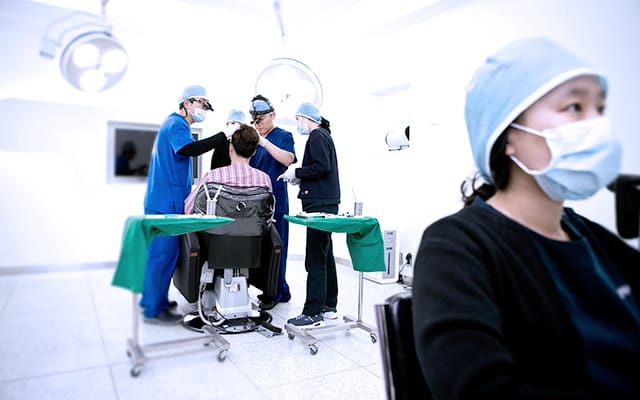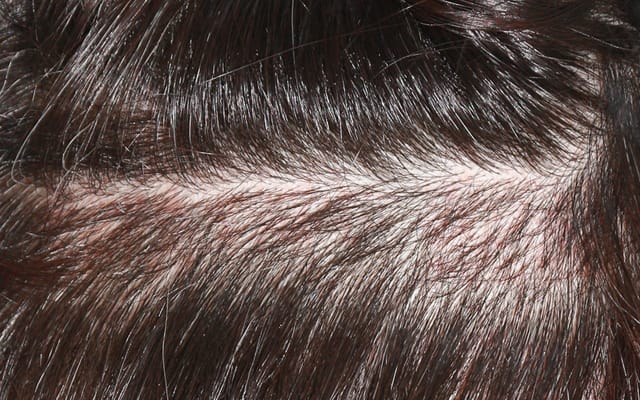FUE vs FUT

Q&A by actual patients
Do not ask around.
FORHAIR will provide you with
the most accurate and truthful information.
Before and After,
You will agree that our engraftment rate is higher.
FUE hair transplant results at FORHAIR are very natural because the changes are truly dramatic.
Different surgical methods do not induce an absolute difference in success rate. The only difference arises from the skill of the physicians. Although the FUE method incurs slightly higher costs since the pain and scars of the existing incisional method are reduced remarkably, patients who underwent surgical procedures at FORHAIR frequently comment that it did not particularly seem more expensive. This is evidence of a very high level of satisfaction after surgery. Why, then, is this technique controversial only in Korea?
Due to the development of the non-incisional method, patients can now undergo hair transplant more conveniently while physicians are confronted with a more complicated and difficult procedure. Compared with FUT hair transplant, FUE hair transplant requires substantially greater concentration, labor, and time. In other words, FUE hair transplant can be conducted only if these requisites are met on the part of the hospital
We carefully presume that the controversy over the low success rate of FUE hair transplant began for such reasons.
FORHAIR is concerned only with providing the best results for patients by means of the best method.
It is an misconception arose because FUE requires more operation time.
Since each hair follicle is collected one-by-one in FUE, it does require more time in comparison to FUT(Follicular Unit Transplantation).
However, on the other hand, when hair follicles are quickly and accurately implanted by a highly experienced physician,
it is possible to increase the engraftment rate.
Since FORHAIR maintains the principle of implanting hair follicles within 1 hour of collection,
we achieve an average graft survival rate of 97%.
To prevent damage. we keep hair follicles in a solution used for actual preservation of organs as well as in a physiological saline solution. As such, the hair
follicle damage rate depends entirely on the skill of physicians and the level of collaboration among experienced surgical teams rather than on the surgical technique itself.
to prevent follicle damage.
the head look empty
if partial shaving
is executed?
It is a concern that quite many people have and in fact, there are many cases. Collecting hair follicles from one concentrated part of occipital region can cause the area look empty.
This is because most healthy and good hair is concentrated on the back of the head. Partial shaving results in a slight occurrence of hair density in the area of collection and non-collection. Occasionally, sensitive people can tell the difference. Accordingly, there are a lot of patients who prefer the FUE hair transplant without any shaving at all over partial shaving.
Under no circumstances does FORHAIR collect hair follicles to the extent of creating aesthetic problems due to a drop in hair density in the occipital region.
We maintain residual density in excess of 75% of existing hair after surgery by only collecting from approximately 25% of the partial shaving area, thereby ensuring that it is not easily noticeable.
In addition, FORHAIR produces maximum effect from a smaller number of hair follicles. There are 1~4 hair strands on each hair follicle. As such, we achieve maximum effect with minimal hair follicles by collecting follicles with 2~3-hair strands rather than single-stranded follicles. It is substantially more efficient to implant 100 hair strands by collecting 50 follicles rather than implanting 100 strands by collecting 100 follicles. FORHAIR produces natural looking hair transplant that cannot be noticed even from a distance of 1m, by preventing density reduction in the occipital region.
Suture scars are produced by FUT hair transplant, since it involves the scalp being cut out. Although the FUE hair transplant method markedly reduces such scarring, it is not completely scar-free, since a punching process is needed in collection.
Depending on the individual, scars may not show at all or they could appear in the form of white spots on the scalp from the 1mm-diameter punching procedure. However, this does not generate aesthetic problems since they will be fully covered once hair grows by just 1cm .
of scar prevention
Normally, FUE hair transplant method involves collecting hair follicles using a circular punch with a diameter of 0.8~1.2mm, and the size of the punch used differs depending on the surgeon. Although it is possible to collect hair follicles more easily if the diameter is larger, it is inevitable that scars are bigger when larger holes are made in the scalp. While it is possible to reduce scar size by using a punch of smaller diameter, this creates a higher possibility that hair follicles get cut.
Therefore, there is no such thing as a punch of absolutely ideal size, and surgeons change the punch size if the rate of cut follicles increases during collection. As such, even the use of the punch requires a high level of surgical experience and expertise.
It is a false fact that FUE hair transplant can’t tell the direction of hair growth when shaven method is taken to cut the hair to 1mm.
FORHAIR executes slit implantation rather than using a hair implanting device. At this time, if slits are made in the direction of the existing hair, new hair growth will occur in the same direction.
During the collection, we check both hair curl and its direction. Also, for implantation, we make SLIT considering characters of surrounding hairs. Even in the case of rapid change in hair direction on the crown of the head or hair lying flat on the hairline and sideburns, it is possible to achieve a natural hair direction by minutely adjusting the slit angle. In addition, hair characteristically changes in accordance with the surrounding environment of the recipient area, so will settle in very naturally in a similar manner as the original hair within approximately 1~2 years of implantation.
of SLIT angle & direction
Patients have a lot to worry since the surgical methods recommended by each hospital differ. As such, we would like to offer some explanation of medical standards, since there exists marked deviation depending on cost possibility of shaving, scars, and recovery period, etc. The important issue is the different scalp characteristics of each individual.
The FUT method can be restrictive unless the scalp has good resilience, since it is a technique that involves cutting up the hair follicle collection area and suturing the scalp. As such, if the scalp has good resilience then there is no difficulty even if the collection area is widened. However, if the scalp has poor resilience, skin will be pulled out at the time of suturing and blood circulation will be degraded. If blood is not supplied harmoniously, it will not only result in a drop in the engraftment rate, but also increase the possibility of accompanying falling off of the hair around the suture, and even necrosis in severe cases. Pain and an extended recovery period due to incisions are other factors that need to be considered.
On the other hand, FUE hair transplant can be executed regardless of scalp characteristics because hair follicles are collected one-by-one without incision.
Surgery will be possible for the majority of patients, with the exception of cases of impossible
collection in the normal method due to significant problems in the scalp itself, or cases in which reduction
of existing incisional scarring is necessary, although theses are very rare. If it is not possible to shave or
partially shave hair due to the patient’s employment circumstances,
FORHAIR can also execute surgery without shaving (C2G). However, the cost of this is higher and requires
an even higher surgeon skill level. As such, few hospitals are able to execute this technique.


 Partial-shaven FUE,
Partial-shaven FUE, Non-shaven FUE, 1200 grafts, After 9 months
Non-shaven FUE, 1200 grafts, After 9 months







 Optimal hair follicle collection to minimize scarring
Optimal hair follicle collection to minimize scarring
 Nearly visible donor site scar
Nearly visible donor site scar



 There is no problem in suturing after the
There is no problem in suturing after the There will be a drop in blood circulation
There will be a drop in blood circulation